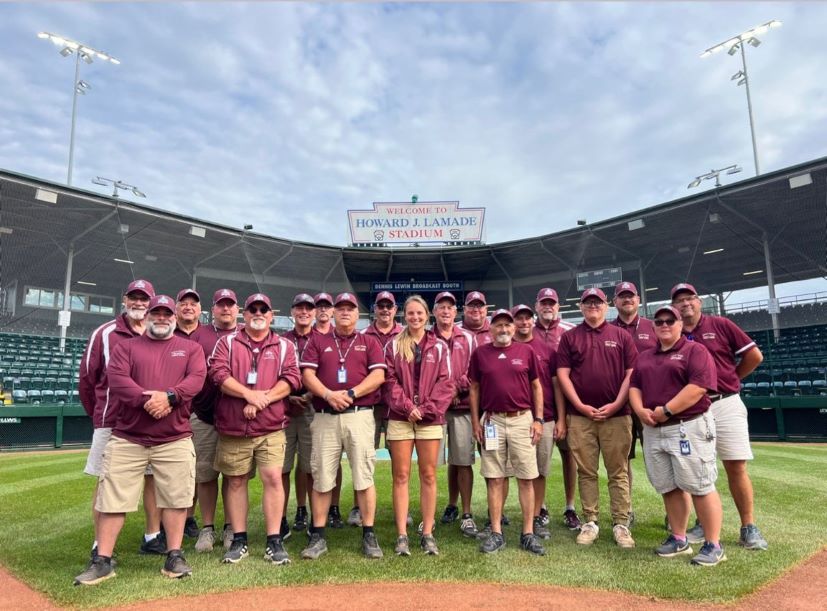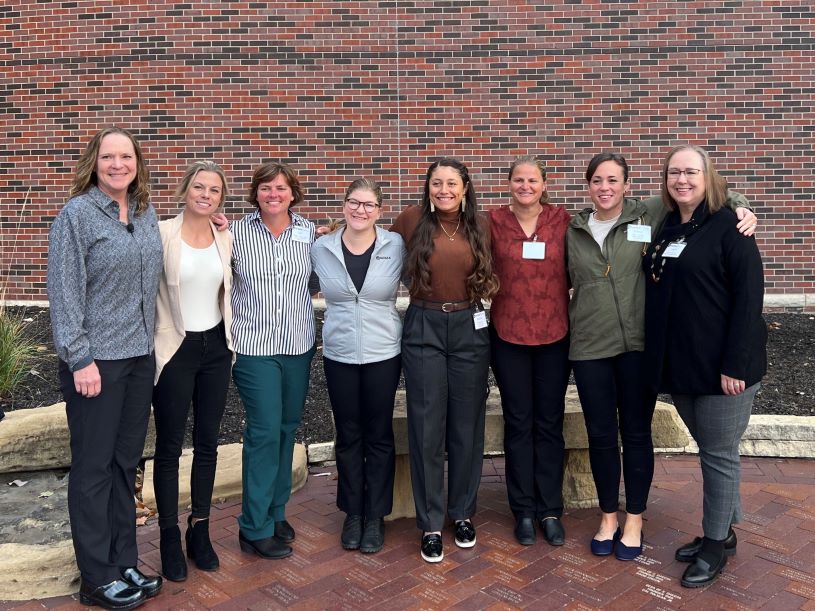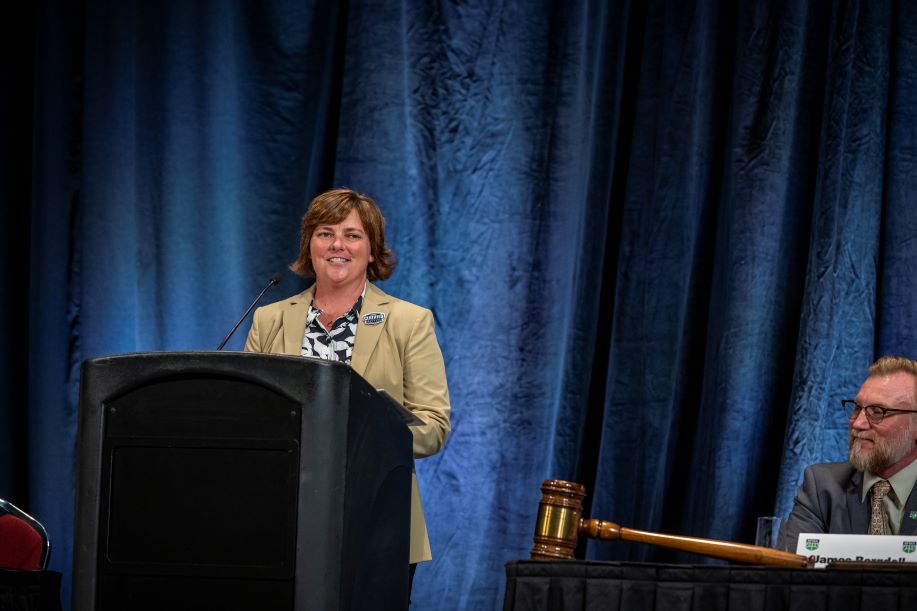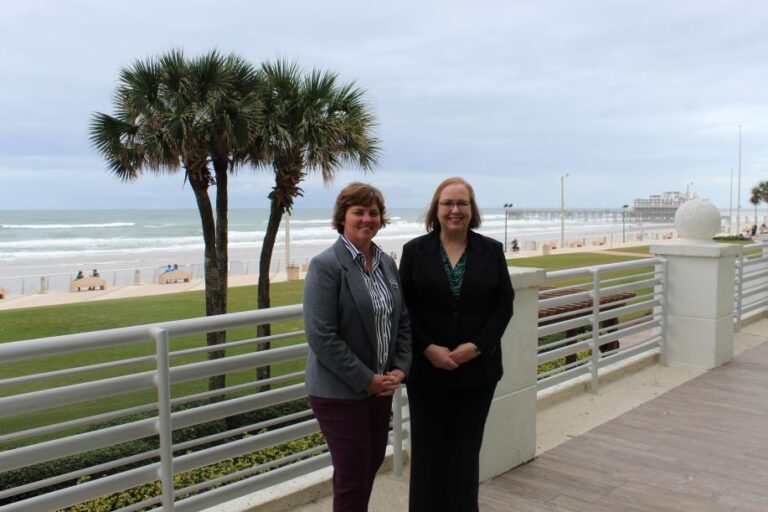By John Kmitta
“The chance to serve a second term as president is exciting,” said Sun Roesslein, CSFM, who is embarking on a rare second year as SFMA President. “The biggest advantage is to provide continuity in supporting our CEO as she continues to identify growth opportunities and lay the groundwork for the future of SFMA.”
According to Roesslein, 2023 focused mostly on back-of-house investments and process improvements for SFMA, so 2024 can be more outwardly focused.
“Just due to the timing, a few of us have had the privilege to bridge the gap – working with Kim Heck prior to her retirement, working closely with the headquarters staff in the interim, and now working with Laura as we start the new phase of SFMA,” said Roesslein. “I can bring a little of the past institutional knowledge for reference as we grow into the next phase. Now I get to have a front-row seat to witness how the systems we are updating will support our membership in increasing ways.”
Roesslein is pleased to have the opportunity to work with Laura Simmons, MBA, CAE, who recently completed her first year as SFMA CEO.
“Laura brought the association management experience SFMA needed when she was first hired, and is learning our membership and profession quickly,” said Roesslein. “Helping Laura build a strong foundation in her first year in order to set SFMA up for continued growth has been a fantastic experience. Working together with the passionate board members who represent all segments of membership has really shown we are all dedicated to working toward an even stronger association for our peers.”
According to Simmons, the biggest challenge during her first year as SFMA CEO has been learning about the past, present and future plans of SFMA.
“This included the analysis of operations and infrastructure and how we can serve our members better,” she said. “I’ve learned so much, and we are very fortunate to have a great team in place that is dedicated to our members and providing them the service and support they want and need.”
Simmons added that the highlight of the past year has been meeting many SFMA members.
“I have enjoyed learning about the profession, visiting chapters, engaging with our volunteers and learning more about SFMA’s history and goals for the future beyond the formal strategic initiatives,” said Simmons.
Meeting with SFMA members during 2023 was a highlight for Roesslein as well.
“I’ve had the chance to connect with members all over the country – attending local events, following more people on social media and having conversations,” she said. “The opportunity to serve our membership is incredibly impactful, and something I never could have understood until truly diving in.”
Initiatives
According to Roesslein, SFMA focused on building a stronger chapter support plan in order help SFMA’s chapter network better support field managers at the local level in 2023. The committee structure has also been revamped for 2024 to encourage continuing progress that more than 200 volunteers make in each committee’s focus area.
“We have been hosting virtual town hall discussions, and I’ve been able to meet with the leadership of several chapters,” added Simmons. “This has been enlightening, as each chapter is unique and confirmed what we already knew – that there is no one-size-fits-all formula for chapter success. We will continue working with each chapter and supporting them as they overcome challenges and strive toward their goals.”
SFMA President-elect Adam Thoms, Ph.D., added that SFMA is continually working on initiatives tied to its strategic plan, and progress on those efforts is reviewed during each SFMA Board of Directors meeting.
Said Roesslein, “2023 felt like a year of regrouping and resetting the foundation to have the infrastructure in place in order to accomplish the goals set forth in our strategic plan. Any good goal-setting coach will tell you that you have to break the big goal down into smaller, measurable and achievable steps in order to succeed. In 2024 we have the opportunity to get back to fully focusing on implementing the business plan set in place.”

Growing the profession
Ongoing goals for SFMA are to grow membership and be more inclusive of underrepresented groups, Simmons added.
“This not only will benefit the association and the networking opportunities for our members, but hopefully will help address the workforce shortage within the profession,” she said. “We are reviewing our communication strategies, and are working diligently on increasing the public’s awareness of the profession – gaining respect for sports field managers and the work they do to provide safe, playable, and beautiful fields for our communities.”
Awareness of the profession is also tied to SFMA’s initiatives related to diversity, equity and inclusion (DEI).
“We welcome everyone into the profession, but first they must know it is an option – and that there are many entry points available,” said Simmons.
SFMA has also been working with partner iCEV to create a turfgrass certification for high schools and career education programs as part of an effort to bring younger and more diverse individuals into the profession.
In the summer of 2024, SFMA will launch more online learning opportunities to help sports field management professionals earn more respect, and, in turn, grow respect for the industry as a whole.
“From an educational standpoint, we are continually seeking methods to educate and engage our members through cutting-edge research, new technologies and innovative ideas,” said SFMA Academic Director Chase Straw, Ph.D. “We are placing a strong emphasis on developing programs that will expand the sports field management industry and association.”
“At the recent conference in Daytona Beach, we announced the launch of our mentorship program,” said Simmons. “This will facilitate the building of bridges between seasoned professionals and those newer to sports field management. Personal and positive engagement is the best way to strengthen commitments to the profession.”
Simmons added that she has met with representatives from other associations that serve related fields, and plans to strengthen those relationships and collaborations for the benefit of SFMA members.
Added Roesslein, “Working with peer associations is one way to help provide more support for our SFMA membership in a variety of paths. This is an ongoing effort, but one specific collaboration from early in 2023 was the social media campaign with the Grounds Management Association (GMA) out of the UK. SFMA was invited to take part in supporting the campaign that promotes the expertise of grounds managers, and they expanded to also promote sports field managers.
“Another example is the Women’s Leadership Academy hosted by the GCSAA,” she added. “This unique event was opened to applications from our membership as well as theirs and SFMA had eight representatives in the inaugural class of 40 women.”
SFMA has also had invitations to attend the National Recreation and Park Association, Professional Grounds Management Society and Golf Course Superintendents Association of America (GCSAA) conferences, which will continue to open doors to collaboration.
“Each peer association has specific areas of expertise that SFMA members can benefit from, and it is my hope that by building relationships with other associations we can tap into those cross-over resources,” said Roesslein.

Labor
According to Simmons, awareness of careers in sports field management is also key to addressing the ongoing labor shortages in the sports field management profession.
“We are working on marketing/awareness campaign strategies, bringing more of our communications efforts in house for more immersive knowledge of the profession, the challenges and most importantly the benefits,” said Simmons. “We plan to get more messaging out to key audiences to educate the public on the importance of having qualified sports field managers maintaining fields and complexes.”
Added Straw, “The key lies in finding ways to inform young people about the career opportunities available in this field and demonstrating the value that skilled sports field managers bring to sports organizations, collegiate athletics, parks and recreation facilities and more.”
Simmons added that the iCEV curriculum will help with these efforts, as it will allow high school students to acquire turfgrass certifications and introduce them to the profession.
“We are confident that once turfgrass education is introduced into more high schools and career education programs, the interest in and pursuit of a career in sports field management will increase,” she said.
Straw added that SFMA has four programs specifically aimed at attracting youth to sports field management industry:
- SFMA 101, a training course offering continuing education opportunities;
- iCEV, a national online turfgrass curriculum providing instructional materials and certification testing for career technical educators;
- Cue Career, an online platform where students learn about careers through direct interaction with professional associations;
- And the chapter ambassador program, designed for chapters to engage middle school and high school students in learning about the industry.
According to Straw, the SFMA Turfgrass Science Certification, available through iCEV in August 2024, will verify that individuals have acquired foundational knowledge and skills in turfgrass science and management, and are capable of pursuing a career in the turfgrass industry.
“We are collaborating with groups like FFA and the GCSAA to develop joint strategies to attract young people to our industry,” he said.
Thoms added that it is important to continue to spread the message that sports field management is a career.
“So many people I run into say they didn’t know you could care for athletic fields as a career, or say they wished they knew about this career at a younger age. Reaching out to high schools will be key in the upcoming years to attract youth to our industry.
Natural vs. synthetic
SFMA leaders also weighed in on the often hot-button issue of natural grass fields vs. synthetic turf.
According to Simmons, research and education are important for helping communities determine the best options for their needs, taking into account the expertise of the sports field manager and the importance of having the proper maintenance plans and professionals in place regardless of what the field is comprised of.
“Again, this is where growing the respect for the expertise a sports field manager can provide is imperative,” she said.
Said Straw, “We require more unbiased information about the economic, environmental and social impacts of field type and management. This can be achieved by conducting large-scale research projects that address these key issues, thereby providing decision makers with science-based data to make the best possible decisions for their facilities.
“Unfortunately, funding for sports field research is limited, making such research projects challenging to conduct,” Straw added. “Nonetheless, efforts are still being made by numerous turfgrass scientists and key stakeholder groups across the country to address these concerns and provide information.”
Thoms echoed Straw’s sentiments.
“So little research is actually funded focusing on athletic field safety, and this needs to increase to help give quantifiable data,” he said. “Also, the field managers need more say in how the fields are used. They also need to be at the table when improvements are proposed as they can best answer what can be done to improve the field.”
Technology and innovation
“I believe that robotic mowers are here to stay, and they will only continue to improve and become more affordable,” Straw said of technological innovations that are impacting the industry. “GPS painters and sprayers are already making a significant impact in terms of labor savings and efficiency. I am particularly excited about the role that artificial intelligence will play in our industry in the coming years.”
According to Straw, these newer technologies – in conjunction with data collection devices such as weather and soil moisture sensors – will become integrated to form a more robust, data-driven decision and action platform.
“This integration is likely to lead to a reduction in management inputs and result in fields that are safer and more playable,” he said.
Thoms is excited to see what is learned from the FIFA World Cup Research with the 2026 World Cup rapidly approaching.
“This will have implications for many years down the road on how to incorporate technology, cultivar performance under athletic field stress, and new maintenance techniques into the athletic field industry,” he said. “Attending presentations on this research will be exciting over the next couple of years and should be on everyone’s radar.”
Sustainability
With regard to sustainability initiatives, Straw said continued education and outreach – within and outside of the industry – are essential.
“Sports field management often faces criticism for various reasons, such as concerns over water, fertilizer and pesticide use for natural turfgrass, and issues like heat, PFAS or microplastics for synthetic turf,” said Straw. “The more science-based information we can provide to managers, decision makers and the public, the clearer it will become that our industry is striving to manage fields in the most sustainable way possible – balancing economic, environmental and social responsibilities.”

Supporting the industry
“The team in the board room is dedicated to working toward elevating our profession, supporting all segments of membership, offering more resources and setting SFMA up for future growth,” said Roesslein. “This group of volunteer board members, alongside our small-but-mighty staff and more than 200 committee volunteers have a lot of opportunity ahead of us in order to achieve our strategic goals and effect positive impact for the roughly 2,300 members of our association. In turn, that will benefit the millions of athletes that play on our fields every day.
“While the road map of our strategic plan is in place, we still need creative ideas and solutions, as well as diverse experiences in order to continue to evolve,” she added. “I encourage you to jump in and sign up for a committee that aligns with your passion for our profession. The old adage, ‘a rising tide lifts all ships,’ rings true in that as we elevate our offerings and resources, we will also elevate our profession; and as we elevate our profession, we elevate our members.”
John Kmitta is associate publisher and editorial brand director of SportsField Management magazine.


